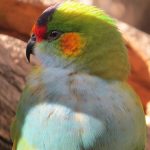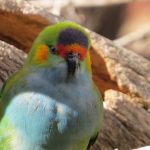PURPLE-CROWNED LORIKEET
PURPLE-CROWNED LORIKEET
PURPLE-CROWNED LORIKEET
The Purple-crowned Lorikeet ( Parvipsitta porphyrocephala) is a small parrot with a vibrant and colorful plumage.
It has a predominantly green body with a purple crown that extends from the forehead to the nape of the neck. The chest and belly are yellow, and it has blue patches on the face, wings, and tail. Like other lorikeet species, it has a specialized brush-tipped tongue for feeding on nectar and pollen.
These lorikeets are endemic to the tropical rainforests of north-eastern Australia. They are typically found in dense, moist forests, including both lowland and upland areas. They rely on the presence of flowering trees and plants for their nectar-rich diet.
Purple-crowned Lorikeets are highly social birds and are usually seen in small flocks or family groups. They are active and agile, displaying acrobatic flight as they move through the forest canopy. They feed primarily on nectar, pollen, and soft fruits, using their specialized tongue to extract the sweet liquid from flowers.
Breeding season for Purple-crowned Lorikeets typically occurs between September and January. They nest in tree hollows, usually high up in the forest canopy. The female lays a clutch of 2 to 4 eggs, which are incubated by both parents for around 25 to 27 days. After hatching, the chicks are cared for by both parents until they fledge and become independent.
Like many parrot species, they face threats such as habitat loss due to deforestation and land clearing. Conservation efforts focus on preserving their rainforest habitats and raising awareness about the importance of their conservation.
The Purple-crowned Lorikeet is a visually striking and ecologically important species within its range. Protecting their habitat and maintaining healthy ecosystems are essential for their long-term survival


